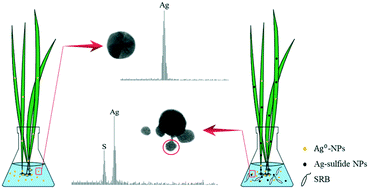当前位置:
X-MOL 学术
›
Environ. Sci.: Nano
›
论文详情
Our official English website, www.x-mol.net, welcomes your
feedback! (Note: you will need to create a separate account there.)
Sulfate-reducing bacteria (SRB) can enhance the uptake of silver-containing nanoparticles by a wetland plant
Environmental Science: Nano ( IF 5.8 ) Pub Date : 2020/01/15 , DOI: 10.1039/c9en01162e Zuo-shun Niu 1, 2, 3, 4, 5 , Yi Yang 1, 2, 3, 4, 5 , Fei-yun Tou 1, 2, 3, 4, 5 , Xing-pan Guo 1, 2, 3, 4, 5 , Rong Huang 3, 5, 6, 7 , Jie Xu 8, 9, 10, 11 , Yu-ru Chen 1, 2, 3, 4, 5 , Li-jun Hou 3, 5, 7, 12, 13 , Min Liu 1, 2, 3, 4, 5 , Michael F. Hochella 11, 14, 15, 16, 17
Environmental Science: Nano ( IF 5.8 ) Pub Date : 2020/01/15 , DOI: 10.1039/c9en01162e Zuo-shun Niu 1, 2, 3, 4, 5 , Yi Yang 1, 2, 3, 4, 5 , Fei-yun Tou 1, 2, 3, 4, 5 , Xing-pan Guo 1, 2, 3, 4, 5 , Rong Huang 3, 5, 6, 7 , Jie Xu 8, 9, 10, 11 , Yu-ru Chen 1, 2, 3, 4, 5 , Li-jun Hou 3, 5, 7, 12, 13 , Min Liu 1, 2, 3, 4, 5 , Michael F. Hochella 11, 14, 15, 16, 17
Affiliation

|
The presence of sulfate-reducing bacteria (SRB) can reduce the bioavailability of toxic metal ions (e.g., Ag+) to plants via mediating the formation of metal sulfide precipitates; however, it remains largely elusive if SRB can also affect the phyto-uptake of metal nanoparticles (e.g., Ag0-NPs). In the current study, the bioavailability of Ag0-NPs to a model wetland plant, Scirpus triqueter, was investigated in the presence/absence of SRB. Comparative experiments were conducted using 0.01–10 mg L−1 Ag0-NPs and silver ions. In addition to quantifying the total dissolved Ag concentrations, we analyzed the average sizes and particle concentrations of Ag-containing NPs (Ag-NPs) in plant tissues, including both roots and stems, after the designated treatments. The results show that although the presence of SRB can reduce the uptake of total Ag by 37% during the exposure of the plant to Ag ions, it can significantly enhance the uptake of total Ag during exposure of the plant to Ag0-NPs, likely by transforming Ag0-NPs into Ag-sulfide NPs with smaller particle sizes. Transmission electron microscopy data revealed that biogenic secondary Ag-sulfide particles smaller than 10 nm in size form in the vicinity of pristine Ag0-NPs. These NPs are likely generated from the parent Ag0-NPs via a dissolution–diffusion–sulfidation process. Moreover, the phyto-uptake of Ag0-NPs of various sizes (i.e., 20, 40 and 80 nm) in the presence/absence of SRB also confirmed a size dependent pattern, with more silver identified in the plant exposed to smaller Ag-NPs. The combined results suggest that the enhanced bioavailability of Ag-NPs to Scirpus triqueter in the presence of SRB is mainly attributed to the formation of secondary biogenic NPs with minute size. This result points to the importance of complex, coupled interactions between aqueous solutions, bacteria, plants, and labile NPs.
中文翻译:

硫酸盐还原细菌(SRB)可以增强湿地植物对含银纳米颗粒的吸收
硫酸盐还原细菌(SRB)的存在可以通过介导金属硫化物沉淀的形成而降低有毒金属离子(例如Ag +)对植物的生物利用度;然而,SRB是否也可以影响金属纳米颗粒(例如,Ag 0 -NPs)的植物吸收仍然遥遥无期。在当前的研究中,研究了在有无SRB的情况下,Ag 0 -NP对模型湿地植物Scirpus triqueter的生物利用度。使用0.01–10 mg L -1 Ag 0进行比较实验-NPs和银离子。除了量化总溶解的Ag浓度外,我们还分析了指定处理后植物组织(包括根和茎)中含Ag NPs(Ag-NPs)的平均大小和颗粒浓度。结果表明,尽管SRB的存在可以在植物暴露于Ag离子的过程中将总Ag的吸收降低37%,但它可以显着提高植物暴露于Ag 0 -NPs的过程中对总Ag的吸收。通过将Ag 0 -NPs转变为粒径较小的Ag-硫化物NPs。透射电子显微镜数据显示,在原始Ag 0附近形成了尺寸小于10 nm的生物次级硫化银颗粒。-NP。这些NP可能是通过溶解-扩散-硫化过程从母体Ag 0 -NP生成的。此外,在存在/不存在SRB的情况下,各种大小(即20、40和80 nm)的Ag 0 -NP的植物吸收也证实了大小依赖性模式,在植物中发现更多的银暴露于较小的Ag- NP。综合结果表明,在SRB存在下,Ag-NPs对Scirpus triqueter的提高的生物利用度主要归因于次生生物NPs的形成。该结果指出了水溶液,细菌,植物和不稳定NP之间复杂,偶联相互作用的重要性。
更新日期:2020-03-21
中文翻译:

硫酸盐还原细菌(SRB)可以增强湿地植物对含银纳米颗粒的吸收
硫酸盐还原细菌(SRB)的存在可以通过介导金属硫化物沉淀的形成而降低有毒金属离子(例如Ag +)对植物的生物利用度;然而,SRB是否也可以影响金属纳米颗粒(例如,Ag 0 -NPs)的植物吸收仍然遥遥无期。在当前的研究中,研究了在有无SRB的情况下,Ag 0 -NP对模型湿地植物Scirpus triqueter的生物利用度。使用0.01–10 mg L -1 Ag 0进行比较实验-NPs和银离子。除了量化总溶解的Ag浓度外,我们还分析了指定处理后植物组织(包括根和茎)中含Ag NPs(Ag-NPs)的平均大小和颗粒浓度。结果表明,尽管SRB的存在可以在植物暴露于Ag离子的过程中将总Ag的吸收降低37%,但它可以显着提高植物暴露于Ag 0 -NPs的过程中对总Ag的吸收。通过将Ag 0 -NPs转变为粒径较小的Ag-硫化物NPs。透射电子显微镜数据显示,在原始Ag 0附近形成了尺寸小于10 nm的生物次级硫化银颗粒。-NP。这些NP可能是通过溶解-扩散-硫化过程从母体Ag 0 -NP生成的。此外,在存在/不存在SRB的情况下,各种大小(即20、40和80 nm)的Ag 0 -NP的植物吸收也证实了大小依赖性模式,在植物中发现更多的银暴露于较小的Ag- NP。综合结果表明,在SRB存在下,Ag-NPs对Scirpus triqueter的提高的生物利用度主要归因于次生生物NPs的形成。该结果指出了水溶液,细菌,植物和不稳定NP之间复杂,偶联相互作用的重要性。











































 京公网安备 11010802027423号
京公网安备 11010802027423号